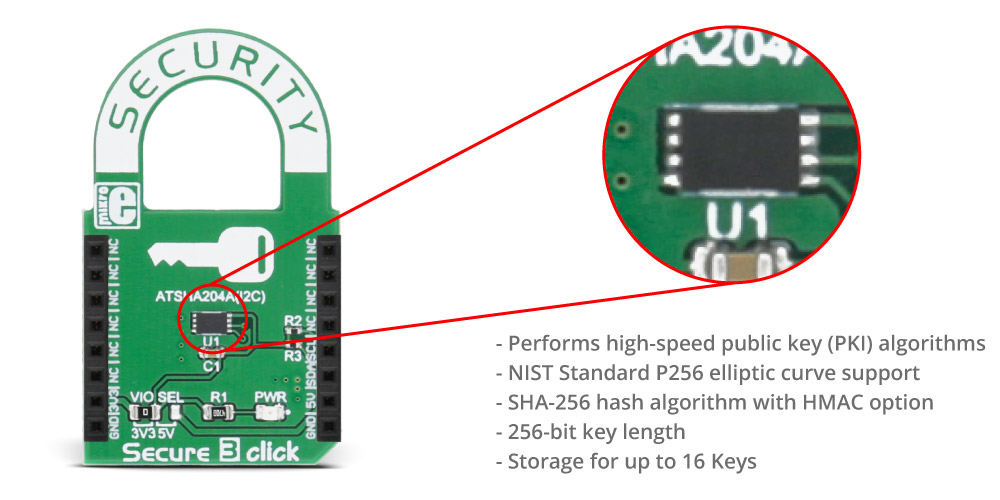Secure 3 click carries the ATSHA204A, a cryptographic coprocessor with secure hardware-based key storage from Microchip. The click is designed to run on either 3.3V or 5V power supply. Secure 3 click communicates with the target microcontroller over an I2C interface.
It is ideal to use for:
- Secure download and boot - authentication and protect code in-transit
- Ecosystem control - ensure only OEM/licensed nodes and accessories work
- Anti-cloning - prevent building with identical BOM or stolen code
- Message security - authentication, message integrity, and confidentiality of network nodes (IoT)
NOTE: The click comes with stacking headers which allow you to combine it with other clicks more easily by using just one mikroBUS??? socket.
ATSHA204A features
The ATSHA204A is a member of the Microchip CryptoAuthentication??? family of high-security hardware authentication devices, which uses Secure Hash Algorithm (SHA-256) with 256-bit key length, message authentication code (MAC) and hash-based message authentication code (HMAC) options. It has a flexible command set that allows use in many applications.

The ATSHA204A device includes an Electrically Erasable Programmable Read-Only Memory (EEPROM) array that can be used for key storage, miscellaneous read/write data, read-only, secret data, consumption logging, and security configuration. Access to the various sections of memory can be restricted in a variety of ways, and the configuration can then be locked to prevent changes.
Specifications
| Type |
EEPROM |
| On-board modules |
ATSHA204A - a cryptographic coprocessor with secure hardware-based key storage |
| Key Features |
superior SHA-256 hash algorithm with 256-bit key length, message authentication code (MAC) and hash-based message authentication code (HMAC) options, storage for up to sixteen keys
|
| Key Benefits |
cost-effective symmetric authentication solution |
| Interface |
I2C |
| Input Voltage |
3.3V or 5V |
| Click board size |
M (42.9 x 25.4 mm) |
Pinout diagram
This table shows how the pinout on Secure 3 click corresponds to the pinout on the mikroBUS??? socket (the latter shown in the two middle columns).
| Notes | Pin |  | Pin | Notes |
|---|
|
NC |
1 |
AN |
PWM |
16 |
NC |
|
|
NC |
2 |
RST |
INT |
15 |
NC |
|
|
NC |
3 |
CS |
TX |
14 |
NC |
|
|
NC |
4 |
SCK |
RX |
13 |
NC |
|
|
NC |
5 |
MISO |
SCL |
12 |
SCL |
I2C clock |
|
NC |
6 |
MOSI |
SDA |
11 |
SDA |
I2C data |
| Power supply |
+3.3V |
7 |
3.3V |
5V |
10 |
+5V |
Power supply |
| Ground |
GND |
8 |
GND |
GND |
9 |
GND |
Ground |
Jumpers and settings
| Designator | Name | Default Position | Default Option | Description |
|---|
| JP1 |
VIO SEL. |
Left |
3V3 |
Power Supply Voltage Selection 3V3/5V, left position 3V3, right position 5V |
Programming
Code examples for Secure 3 click, written for MikroElektronika hardware and compilers are available on Libstock.
Code snippet
The following code snippet creates a MAC for a given input and then checks if it is valid using verify function.
01 static void MACTest ()
02 {
03 //Generates nonce for use in MAC generation
04 memset (bufferIn, 0x45, 128);
05 if (atcab_nonce(bufferIn) == ATCA_SUCCESS)
06 {
07 LOG( "rnrn Nonce generated." );
08 }
09 else LOG( "rnrn Nonce generation failed..." );
10 delay_ms (1500);
11
12 //Generates MAC for given input
13 memset (bufferOut, 0x00, 128);
14 memset (bufferIn, 0x14, 128);
15 if (atcab_mac( 0, 0, bufferIn, bufferOut ) == ATCA_SUCCESS)
16 {
17 LOG( "rnrn MAC generated: " );
18 outputHex (bufferOut, 32);
19 }
20 else LOG( "rnrn Mac generation failed..." );
21 delay_ms (1500);
22
23 //Checks if the generated MAC is valid
24 memset (bufferIn, 0x14, 128);
25 if (atcab_checkmac( 0, 0, bufferIn, bufferOut, otherData) == ATCA_SUCCESS)
26 {
27 LOG( "rnrn Check MAC successful. " );
28 }
29 else LOG( "rnrn Check MAC failed..." );
30 }

